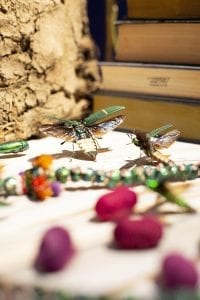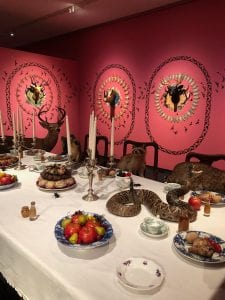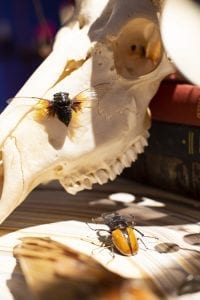October 15, 2019 | By Steven Kenny
The Grasshopper and the Ant and Other Stories, as told by Jennifer Angus
On display through January 5
Museum of Fine Arts, St. Petersburg
Details here

You may be relieved to know that Jennifer Angus’ intention when working with dead insects, her medium of choice, is not to shock or frighten but to entice, elicit wonder, inspire awe, gently educate and entertain.
That’s not to say that topics like climate change, animal cruelty and deforestation don’t run through her work. They do, but artists must choose their own means of addressing urgent issues. One way is through sounding shrill alarms. Angus takes a more playful approach.

Upon entering the exhibition, the first sensation that strikes the visitor is not visual but olfactory — the scent of beeswax! After our eyes adjust we find ourselves in a nearly black room illuminated on one side by two rows of backlit canning jars filled with what turns out to be jam, lovingly made by the artist. In each jar floats, you guessed it, dead insects! Food for the afterlife? On the opposite wall, almost telling us not to be afraid, is a cheery painting illustrating a scene from Aesop’s fable The Grasshopper and the Ant which sets the storybook tone for the rest of the exhibition (and provides its title).
From there we enter the largest space in the exhibition, a bright chartreuse room with delicate patterning covering much of the two-story high walls. But wait! The geometric tracery — snowflake-like and doily-ish towards the ceiling, pink and blue floral shapes at knee level — is actually more dried insects, kaleidoscopically hued, meticulously pinned in place. Resting on the floor but rising above our heads are doll houses on stilts, theoretically accessible by rickety ladders, all dripping with more beeswax.
. .

“Nature will bear the closest inspection.” – Henry David Thoreau
. . .
For me, the feeling was that of having been dropped off at a do-not-touch KinderCare facility for adults. Meanwhile, a working cuckoo clock reminds us of the passage of time. Tempus fugit!
The tone and illumination shifts dramatically in the next room where an elegant candlelit table is set for dinner while being set upon by a wild gang of taxidermied forest animals. Not quite what Dickens’ Miss Havisham had in mind but Lewis Carroll’s Alice might feel comfortable here. You’ll enjoy crashing this party to discover what is on the menu and on the walls. Feast your eyes but save room for dessert. There are many more surprises waiting the next room.

. . .
Turn the corner and we find ourselves in a more studious, but no less whimsical, environment. All the insects, creatures and natural specimens are now safely sealed behind glass. More insect patterning to see but this time in the form of wallpaper. (This makes sense when we learn that Angus is a professor of Design Studies and draws inspiration from textiles.)
Two antique, multi-drawered cabinets present humorous, miniature scenarios played out by Angus’ multi-legged actors cobbled together from broken insect bodies. Each compartment gives the voyeuristic feeling of peering into our own scurrying existence and silly daily dramas. More doll houses, of a sort? Next, large vitrines filled with carefully arranged books, bones and dried plants bring to mind the momento mori warning that we all must die eventually.
So much to see! If you feel the need to rest, the exhibition includes a quiet Victorian sitting room for you to enjoy. Have a seat and relax. You may even bump into the ghosts of Charles Darwin or Queen Victoria herself. . .
On display through January 5
Museum of Fine Arts, St. Petersburg
Find out more here
Explore the work of Jennifer Angus
at jenniferangus.com


